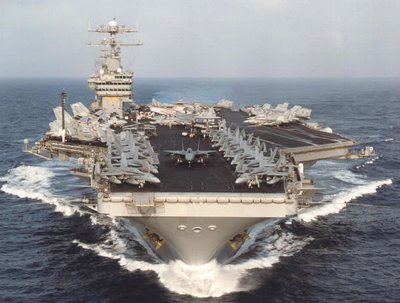
Naming the ships and the countries involved in the coming war with Iran?
Here is one of the few sites to offer a "carefully documented review of the ongoing naval build-up and deployment of coalition forces in the Middle East." The site, Global Research, transmits out of Canada and seems to have some pretty astute academic writers on board.
This extensive article names the three main U. S. naval task forces currently underway to the Persian Gulf, as well as the various duties and ships within each group. Other countries involved are also detailed. The article by Mahdi Darius Nazemroaya is very lengthy and I recommend reading it if for only to acquaint one with who is actually going to be launching the missiles, mining the Iranian harbors and blockading the ports.
An excerpt follows below:
Time Magazine and the “Prepare to Deploy Order” of the Eisenhower Strike Group
The latest U.S. reports provide details of preparations to go to war with Iran and Syria. Time magazine confirms that orders have been given for deployment of a submarine, a battleship, two minesweepers, and two mine-hunters in the Persian Gulf by October 2006. There are very few places in the world where minesweepers would be needed or used besides the Persian Gulf. There also very few places where anti-submarine drills are required , besides the Persian Gulf.
Anti-submarine drills are what Expeditionary Strike Group 5 (EST 5) is performing in the Pacific before it heads to the Persian Gulf, together with Canada's H.M.C.S. Ottawa and units of the U.S. Coast Guard.
The Time Magazine article intimates that the operation could result in heavy American casualties.
“The first message was routine enough: a ‘Prepare to Deploy Order’ sent through naval communications channels to a submarine, an Aegis-class cruiser, two minesweepers and two mine-hunters. The orders didn't actually command the ships out of port; they just said be ready to move by October 1 [2006]. A deployment of minesweepers to the east coast of Iran would seem to suggest that a much discussed, but until now largely theoretical, prospect has become real: that the U.S. may be preparing for war with Iran.”12
Award-winning investigative reporter and journalist Dave Lindorff has written;
[Retired] Colonel Gardiner, who has taught military strategy at the National War College [of the United States], says that the [U.S. Navy] carrier deployment and a scheduled Persian Gulf arrival date of October 21 [2006] is “very important evidence” of war planning. He says, “I know that some naval forces have already received 'prepare to deploy orders’ [PTDOs], which have set the date for being ready to go as October 1 [2006]. Given that it would take about from October 2 to October 21 to get those forces to the [Persian] Gulf region, that looks about like the date” of any possible military action against Iran. (A PTDO means that all crews should be at their stations, and ships and planes should be ready to go, by a certain date—in this case, reportedly, October 1.) Gardiner notes, “You cannot issue a PTDO and then stay ready for very long. It's a very significant order, and it’s not done as a training exercise.” This point was also made in the Time article.
(…)
"I think the plan’s been picked: bomb the nuclear sites in Iran," says [Colonel] Gardiner. "It's a terrible idea, it's against U.S. law and it's against international law, but I think they've decided to do it." Gardiner says that while the United States has the capability to hit those sites with its cruise missiles, "the Iranians have many more options than we [the United States] do.
(…)
Of course, Gardiner agrees, recent ship movements and other signs of military preparedness could be simply a bluff designed to show toughness in the bargaining with Iran over its nuclear program. But with the Iranian coast reportedly armed to the teeth with Chinese Silkworm anti-ship missiles, and possibly even more sophisticated Russian anti-ship weapons, against which the [U.S.] Navy has little reliable defenses, it seems unlikely the Navy would risk high-value assets like aircraft carriers or cruisers with such a tactic. Nor has bluffing been a Bush [Administration] MO [tactic] to date.13
The Pentagon responded to the Time magazine report by stating that the Chief of Naval Operations had merely asked the U.S. Navy to “put ‘fresh eyes’ on old U.S. plans to blockade two Iranian oil ports on the [Persian] Gulf.”14 This response in itself is questionable to analysts. Why would the United States want to stop the flow of oil from Iran, a major petroleum exporting nation, which would harm U.S. allies and the world economy?
Read the complete very detailed article at:
The March to War: Naval build-up in the Persian Gulf and the Eastern Mediterranean.
No comments:
Post a Comment